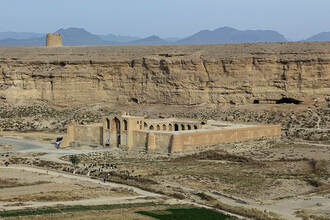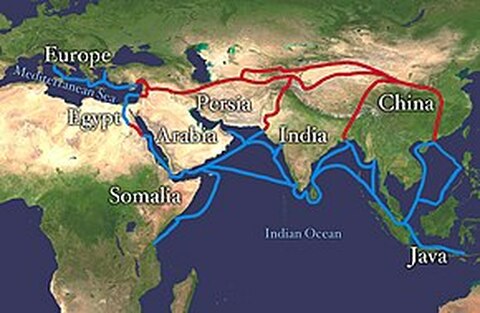 This caravanserai, or roadside inn, provided Silk Road travelers a place to rest and recover during journeys. It was built between the third and fifth centuries CE.
This caravanserai, or roadside inn, provided Silk Road travelers a place to rest and recover during journeys. It was built between the third and fifth centuries CE. Roger M McCoy
When China and ancient Persia (present day Iran) were the two world centers of power, wealth, and culture during the sixth century BCE, it was natural that trade would develop between them. With the rise of the Roman Empire, trade extended westward into Europe. Changes came about when the Romans gained control over much of western Asia and discovered the many luxuries from the Far East. Citizens of Rome gladly embraced these new luxuries and prosperity grew for the Empire as a whole. Eventually the chief Asian export, silk, led to such a change in Roman lifestyle that the writer Seneca, around 60 BCE, claimed that silk caused a decline into social decadence because the new clinging Asian fabric showed too much of the female figure, but few people listened to his rant. In the first century CE, Pliny the Elder complained that the cost of silk was so inflated that an excessive amount of money was being sent to foreign countries. There is ample evidence, however, that Roman goods traveled the trail eastward as well. For example Roman glassware, silver and gold objects, and other artifacts have been discovered in archeological sites in China and the Korean peninsula. Clearly silk was a driving force in international trade.
Naturally Europeans thought of starting their own silk industry. The Byzantine Emperor Justinian, who ruled from 527–565 CE, sent monks to China to steal some highly guarded silkworm eggs. Thus silk production entered into the Mediterranean area centered on Constantinople. Because the quality of Chinese silk was still far superior to anything produced in Europe, silk trade along the trail continued to thrive.
The routes known as the Silk Road eventually formed a widespread network including sea routes from India and China. Goods moving eastward included dates, nuts, and saffron from Persia, glass bottles from Egypt, myrrh from East Africa, and European goods such as fine glassware and objects of gold and silver. In return the caravans brought bolts of silk cloth, lacquerware, and fine porcelain from China, and sandalwood and spices from India via southern routes. Several southward spurs allowed traders to reach the sea and continue the journey by ship. The ocean route of the Silk Road connected China to Southeast Asia, Indonesia, then on to India, Persia, and Egypt. After a short overland transfer at the neck of land where the Suez Canal is now located, goods were carried on to Europe. Not surprisingly silk was used as the common currency along these routes. Towns and merchants along the route also prospered by the passing caravans. On the land routes a network of shelters were built with accommodations and provisions for camels and people, like early-day motels.
In 1271 Marco Polo, who went to China to visit the Kublai Kahn, traveled most of his journey overland along the Silk Road. Polo gave some idea of the immensity and emptiness of the land of Central Asia when he later wrote, “You can ride for twenty days without finding any inhabited spot, so that travelers are obliged to carry all their provisions with them, and we are constantly falling in with those wild beasts which are so numerous and dangerous.” Some analysts of Polo’s writing have found that he sometimes exaggerated and manufactured details. The book of his experiences is titled, Book of the Marvels of the World, usually called, The Travels of Marco Polo.
Although the primary use of the Silk Road was commerce, other important movements also used the Road. Mainly the network of routes making up the Silk Road became important in the spreading and mixing of Greek, Persian, Indian, and Chinese cultures. One example is the spread of religions. Buddhism and Christianity each moved into China along these routes beginning as early as the first century CE. After the seventh century Islam also spread to the east. Unsurprisingly the interaction of these Eastern and Western cultures also influenced their art. One example is the influence of Greek art on India’s Buddhist art, during the period between the conquests of Alexander the Great in the fourth century BCE and the spread of Islam in the seventh century CE. During the seventh century Persian craftsmen emigrated along the road into China bringing finely made works of silver to the great Tang Dynasty.
Part of the Silk Road still exists as a paved highway connecting Pakistan and China. The existing old road was the impetus behind a United Nations plan for a trans-Asian highway and railway. Today the Silk Road has taken a renewed importance as China has made plans to develop improved transportation and trade in Central Asia. In 2013 President Xi Jinping announced that the Silk Road would be reborn as the Belt and Road Initiative, a very ambitious infrastructure project.
Sources
Frankopan, Peter. The Silk Roads: A New History of the World. New York: Vintage
Books, 2017.
Harris, Kate. Lands of Lost Borders: A Journey on the Silk Road. New York: Harper
Collins Publishers, 2018.
Kurlansky, Mark. Salt: A World History. New York: Walker Publishing, 2002.
Monteleone, Davide. A New Silk Road. The New Yorker. January 8, 2018
When China and ancient Persia (present day Iran) were the two world centers of power, wealth, and culture during the sixth century BCE, it was natural that trade would develop between them. With the rise of the Roman Empire, trade extended westward into Europe. Changes came about when the Romans gained control over much of western Asia and discovered the many luxuries from the Far East. Citizens of Rome gladly embraced these new luxuries and prosperity grew for the Empire as a whole. Eventually the chief Asian export, silk, led to such a change in Roman lifestyle that the writer Seneca, around 60 BCE, claimed that silk caused a decline into social decadence because the new clinging Asian fabric showed too much of the female figure, but few people listened to his rant. In the first century CE, Pliny the Elder complained that the cost of silk was so inflated that an excessive amount of money was being sent to foreign countries. There is ample evidence, however, that Roman goods traveled the trail eastward as well. For example Roman glassware, silver and gold objects, and other artifacts have been discovered in archeological sites in China and the Korean peninsula. Clearly silk was a driving force in international trade.
Naturally Europeans thought of starting their own silk industry. The Byzantine Emperor Justinian, who ruled from 527–565 CE, sent monks to China to steal some highly guarded silkworm eggs. Thus silk production entered into the Mediterranean area centered on Constantinople. Because the quality of Chinese silk was still far superior to anything produced in Europe, silk trade along the trail continued to thrive.
The routes known as the Silk Road eventually formed a widespread network including sea routes from India and China. Goods moving eastward included dates, nuts, and saffron from Persia, glass bottles from Egypt, myrrh from East Africa, and European goods such as fine glassware and objects of gold and silver. In return the caravans brought bolts of silk cloth, lacquerware, and fine porcelain from China, and sandalwood and spices from India via southern routes. Several southward spurs allowed traders to reach the sea and continue the journey by ship. The ocean route of the Silk Road connected China to Southeast Asia, Indonesia, then on to India, Persia, and Egypt. After a short overland transfer at the neck of land where the Suez Canal is now located, goods were carried on to Europe. Not surprisingly silk was used as the common currency along these routes. Towns and merchants along the route also prospered by the passing caravans. On the land routes a network of shelters were built with accommodations and provisions for camels and people, like early-day motels.
In 1271 Marco Polo, who went to China to visit the Kublai Kahn, traveled most of his journey overland along the Silk Road. Polo gave some idea of the immensity and emptiness of the land of Central Asia when he later wrote, “You can ride for twenty days without finding any inhabited spot, so that travelers are obliged to carry all their provisions with them, and we are constantly falling in with those wild beasts which are so numerous and dangerous.” Some analysts of Polo’s writing have found that he sometimes exaggerated and manufactured details. The book of his experiences is titled, Book of the Marvels of the World, usually called, The Travels of Marco Polo.
Although the primary use of the Silk Road was commerce, other important movements also used the Road. Mainly the network of routes making up the Silk Road became important in the spreading and mixing of Greek, Persian, Indian, and Chinese cultures. One example is the spread of religions. Buddhism and Christianity each moved into China along these routes beginning as early as the first century CE. After the seventh century Islam also spread to the east. Unsurprisingly the interaction of these Eastern and Western cultures also influenced their art. One example is the influence of Greek art on India’s Buddhist art, during the period between the conquests of Alexander the Great in the fourth century BCE and the spread of Islam in the seventh century CE. During the seventh century Persian craftsmen emigrated along the road into China bringing finely made works of silver to the great Tang Dynasty.
Part of the Silk Road still exists as a paved highway connecting Pakistan and China. The existing old road was the impetus behind a United Nations plan for a trans-Asian highway and railway. Today the Silk Road has taken a renewed importance as China has made plans to develop improved transportation and trade in Central Asia. In 2013 President Xi Jinping announced that the Silk Road would be reborn as the Belt and Road Initiative, a very ambitious infrastructure project.
Sources
Frankopan, Peter. The Silk Roads: A New History of the World. New York: Vintage
Books, 2017.
Harris, Kate. Lands of Lost Borders: A Journey on the Silk Road. New York: Harper
Collins Publishers, 2018.
Kurlansky, Mark. Salt: A World History. New York: Walker Publishing, 2002.
Monteleone, Davide. A New Silk Road. The New Yorker. January 8, 2018

 RSS Feed
RSS Feed
